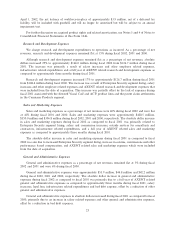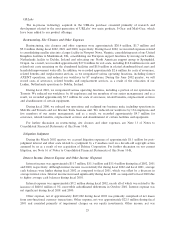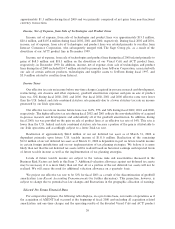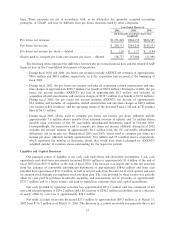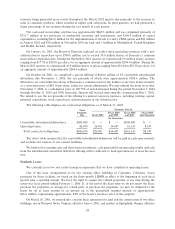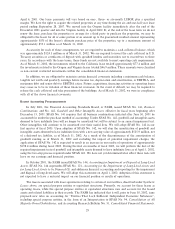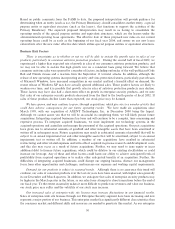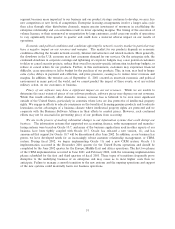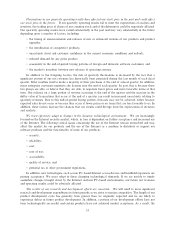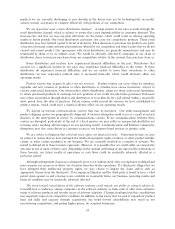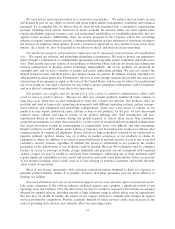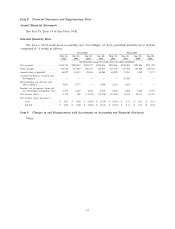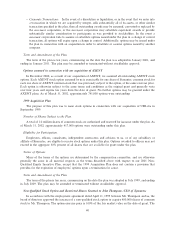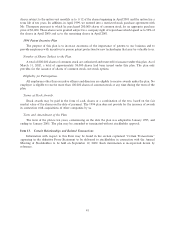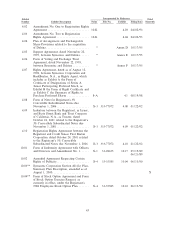Symantec 2002 Annual Report Download - page 55
Download and view the complete annual report
Please find page 55 of the 2002 Symantec annual report below. You can navigate through the pages in the report by either clicking on the pages listed below, or by using the keyword search tool below to find specific information within the annual report.Fluctuations in our quarterly operating results have aÅected our stock price in the past and could aÅect
our stock price in the future. If our quarterly operating results fail to meet the expectations of analysts and
investors, the trading price of shares of our common stock and of the debentures could be negatively aÅected.
Our quarterly operating results have varied substantially in the past and may vary substantially in the future
depending upon a number of factors, including:
‚ the timing of announcements and releases of new or enhanced versions of our products and product
upgrades;
‚ the introduction of competitive products;
‚ uncertainty about and customer conÑdence in the current economic conditions and outlook;
‚ reduced demand for any given product;
‚ seasonality in the end-of-period buying patterns of foreign and domestic software customers; and
‚ the market's transition between new releases of operating systems.
In addition to the foregoing factors, the risk of quarterly Öuctuations is increased by the fact that a
signiÑcant portion of our net revenues has historically been generated during the last month of each Ñscal
quarter. Most resellers tend to make a majority of their purchases at the end of a Ñscal quarter. In addition,
many enterprise customers negotiate site licenses near the end of each quarter. In part, this is because these
two groups are able, or believe that they are able, to negotiate lower prices and more favorable terms at that
time. Our reliance on a large portion of revenue occurring at the end of the quarter and the increase in the
dollar value of transactions that occur at the end of a quarter can result in increased uncertainty relating to
quarterly revenues. Due to this end-of-period buying pattern, forecasts may not be achieved, either because
expected sales do not occur or because they occur at lower prices or on terms that are less favorable to us. In
addition, these factors increase the chances that our results could diverge from the expectations of investors
and analysts.
We must eÅectively adapt to changes in the dynamic technological environment. We are increasingly
focused on the Internet security market, which, in turn is dependent on further acceptance and increased use
of the Internet. The following critical issues concerning the use of the Internet remain unresolved and may
aÅect the market for our products and the use of the Internet as a medium to distribute or support our
software products and the functionality of some of our products:
‚ security;
‚ reliability;
‚ cost;
‚ ease of use;
‚ accessibility;
‚ quality of service; and
‚ potential tax or other government regulations.
In addition, new technologies, such as non PC-based Internet access devices and handheld organizers are
gaining acceptance. We must adapt to these changing technological demands. If we are unable to timely
assimilate changes brought about by the Internet and non PC-based environments, our future net revenues
and operating results could be adversely aÅected.
The results of our research and development eÅorts are uncertain. We will need to incur signiÑcant
research and development expenditures in future periods as we strive to remain competitive. The length of our
product development cycle has generally been greater than we originally expected and we are likely to
experience delays in future product development. In addition, a portion of our development eÅorts have not
been technologically successful and certain products have not achieved market acceptance. As a result, the
33


